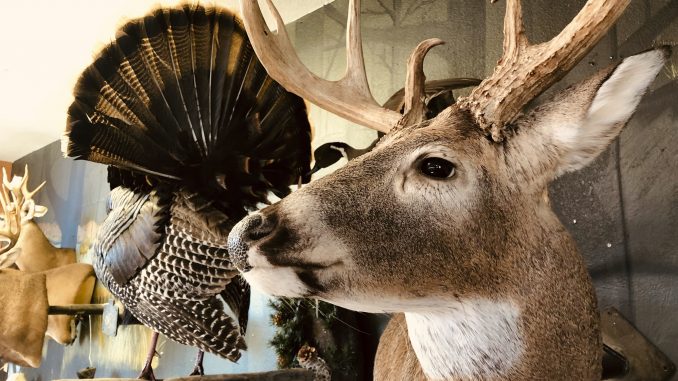
NORFOLK, Va. — The memory is etched in the mind so clearly, that split second when the huge buck walked out of the thicket.
The joy back at home, admiring the take before butchering the animal for steaks, roasts, sausage and burgers, is something that never will be forgotten.
It will help when the deer, from its shoulders up, is hanging on the wall in all its splendor — so lifelike that it seems that moment in time was happening all over again.

Taxidermy is a centuries-old way to preserve parts or all of an animal that is especially popular in the fishing and hunting communities. While fish mounts have migrated from using the animal’s skin to fiberglass reproductions, mammals and birds have remained the real thing. Typically, only the eyes are not part of the animal, although some mannequin companies have perfected life-like teeth and mouth interiors.
In this neck of the woods, white-tailed deer and black bear are the bread and butter for most taxidermists. Turkey mounts also are popular, and taxidermists are seeing more wild hogs.
“It’s an exciting time to be a taxidermist,” said Robbie Anderson, president of the Virginia Taxidermist Association, a group that puts on one of the East Coast’s biggest conventions and competitions in March. “It’s a constantly changing world and there are so many innovations that are making the mounts more and more lifelike. Some taxidermists are even replicating moisture droplets in a deer’s nostrils.
“You have to really look at some of them closely to see that they’re not alive.”
While full-body mounts are nothing new, there has been a growing trend of placing the animal or fish in an environmental situation, adding more realism.
For the last 28 years, self-taught Tim McMahon has run East Coast Taxidermy near Elizabeth City. Like many in the region, he specializes in deer and bear. He’s also done quite a few exotic animals killed abroad.
“It was all trial and error at first,” the 47-year-old said. “I bought all the catalogs I could get my hands on. I drove hundreds of miles to taxidermy shops that I could get into and watch the guys work. It just kind of clicked for me and seemed natural.
“I’ve been working hard at improving all the time. When you stop learning it’s because you’re dead or not trying.”
The basics are simple. A hunter brings in, say, a deer head with a good bit of the skinned-out body, which the taxidermist tans to preserve. All of the inside of the head is removed before tanning. A foam mannequin is purchased and customized to get it as close to the exact size as the deer, then the skin is draped over the form.
“Then it’s all about the small details,” McMahon said.
It helps to have an eye for what the animal looks like in nature, something that taxidermists say gives hunters and anglers a distinct advantage.
“Absolutely,” McMahon said. “Those people know what that animal is supposed to look like.”
Knowing a little bit about an animal’s anatomy doesn’t hurt, either.
“I wouldn’t say you have to be an expert, but it sure helps,” said Bill Clark of Open Acres Taxidermy in Virginia Beach.
Clark took a different route than McMahon, instead heading to Indiana and learning the basics from when a deer was brought in all the way to when it was handed over to a customer. His teacher was a grand master taxidermist. He immediately entered some of his work in contests to gauge how good he was getting. He sought more influence when he returned home to start what has been a 15-year career.
“I’d tell somebody just getting into it not to quit their day job,” he said. “It takes it a while to make it a business where you don’t have another job. And be ready to work when you decide to make it one.”
McMahon agrees that working long hours — especially when deer start coming in — is the only way to make money.
“You can work a few hours a day and make a little money, or you can work 12-hour days and make it a living,” said McMahon, who said he charges about $585 for a standard deer shoulder mount. “But I love it, I think anybody that’s doing it does.
“It’s really amazing to see them come back to life.”
